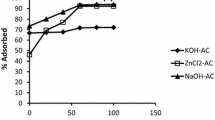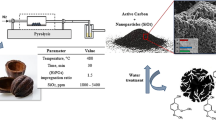Abstract
The effectiveness of activated carbons in the adsorptive removal of 2,4-dinitrophenol (DNP) in aqueous solutions was evaluated both theoretically and experimentally after they were made from coconut shells. Coconut shell was subjected to pyrolysis (600 °C) and chemically activated with various solutions containing phosphoric acid (H3PO4); H3PO4+ and iron (II) salt solution; and H3PO4+ and iron (III) salt solution. Physicochemical analysis: iodine number, pH, pHPZC, bulk density, BET, and surface groups of samples obtained were determined. Some aqueous solution parameters, such as pH, contact time, and absorbent quantity, that have an impact on 2,4-DNP adsorption have been studied. The favorable pH for the adsorption process was found to be 2.0–3.0. The maximum adsorption of 8.0, 10.6, and 14.9 mg/g of 2,4-DNP onto activated carbon was observed at pH 3.0 for CAHP, CAHP@FeII, and CAHP@FeIII, respectively, 120 min contact time for all activated carbon samples. After fitting adsorption data to various kinetic models, it was clear that nonlinear Elovich kinetics was better suited to describe adsorption compared to the linear models with the correlation coefficient R2 greater than 0.96. The DFT results further demonstrated that the compounds under investigation were adsorbed by the process of chemical bonding, and the negative values of the interaction energy confirmed this conclusion. Additionally, the negative adsorption energy values imply that all chemicals have significantly adsorbed to the activated carbon surface by physisorption (electrostatic interactions), chemisorption (n-π bonds), and diffusion into the pores. The exothermic and spontaneous nature of 2,4-DNP adsorption was found, as demonstrated by the increase in adsorption energies and the proximity of the molecules being studied to the activated carbon surface.













Similar content being viewed by others
Data availability
Not applicable.
References
Al-Mutairi NZ (2010) 2, 4-Dinitrophenol adsorption by date seeds: effect of physico-chemical environment and regeneration study. Desalination 250(3):892–901
Azari A, Yeganeh M, Gholami M, Salari M (2021) The superior adsorption capacity of 2, 4-dinitrophenol under ultrasound-assisted magnetic adsorption system: modeling and process optimization by central composite design. J Hazard Mater 418:126348
Uberoi V, Bhattacharya SK (1997) Toxicity and degradability of nitrophenols in anaerobic systems. Water Environ Res 69(2):146–156
Chandrasekaram K, Alias Y, Fathullah SF, Lee VS, Haron N, Raoov M, Zakaria N, Mohamad S (2021) Sporopollenin supported ionic liquids biosorbent for enhanced selective adsorption of 2, 4-dinitrophenol from aqueous environment. Mater Today Commun 28:102587
Kim SJ, Shim WG, Kim TY, Moon H, Kim SJ, Cho SY (2002) Adsorption equilibrium characteristics of 2, 4-dichlorophenoxyacetic acid and 2, 4-dinitrophenol on granular activated carbons. Korean J Chem Eng 19:967–977
Shukla SS, Dorris KL, Chikkaveeraiah BV (2009) Photocatalytic degradation of 2, 4-dinitrophenol. J Hazard Mater 164(1):310–314
Grundlingh J, Dargan PI, El-Zanfaly M, Wood DM (2011) 2, 4-dinitrophenol (DNP): a weight loss agent with significant acute toxicity and risk of death. J Med Toxicol 7:205–212
Miranda EJ, McIntyre IM, Parker DR, Gary RD, Logan BK (2006) Two deaths attributed to the use of 2, 4-dinitrophenol. J Anal Toxicol 30(3):219–222
Zhou C, Xia W, Huang D, Cheng M, Zhang H, Cai T, Xiong W, Yang Y, Song B, Wang W, Zhou M, Zeng G (2021) Strategies for enhancing the perylene diimide photocatalytic degradation activity: method, effect factor, and mechanism. Environ Sci Nano 8(3):602–618
Yusof NA, Zakaria ND, Maamor NAM, Abdullah AH, Haron MJ (2013) Synthesis and characterization of molecularly imprinted polymer membrane for the removal of 2, 4-dinitrophenol. Int J Mol Sci 14(2):3993–4004
Bagal MV, Lele BJ, Gogate PR (2013) Removal of 2, 4-dinitrophenol using hybrid methods based on ultrasound at an operating capacity of 7 L. Ultrason Sonochem 20(5):1217–1225
Wang G, Huang D, Cheng M, Chen S, Zhang G, Du L, Lei L, Chen Y, Li R, Liu Y (2022) An insight into the bridging role of Co3O4 in MOF-derived binary metal oxide modified sheet-like g-C3N4 for photo-assisted peroxymonosulfate activation. Environ Sci Nano 9(12):4393–4410
Huang D, Wang G, Cheng M, Zhang G, Chen S, Liu Y, Xue W, Lei L, Xiao R (2021) Optimal preparation of catalytic metal-organic framework derivatives and their efficient application in advanced oxidation processes. Chem Eng J 421:127817
Mafo Mokue SG, Nanssou Kouteu PA, Tchuifon Tchuifon DR, Fotsop CG, Zue Mve M, Teikam Kenda G, Bopda A, Kuete HIT, Ngakou SC, Nche GN-A, Mouangue MR, Gabche Anagho S (2023) Low-cost magnetic carbons-based rubber seed husks materials for highly efficient removal for reactive black 5 and reactive blue 19 textile dyes from wastewater. Int J Environ Anal Chem 1–25
Kenda GT, Fotsop CG, Tchuifon DRT, Kouteu PAN, Fanle TF, Anagho GS (2024) Building TiO2-doped magnetic biochars from Citrus Sinensis peels as low-cost materials for improved dye degradation using a mathematical approach. Appl Surf Sci Adv 19:100554
Lujanienė G, Šemčuk S, Lečinskytė A, Kulakauskaitė I, Mažeika KS, Valiulis D, Pakštas V, Skapas M, Tumėnas S (2017) Magnetic graphene oxide based nano-composites for removal of radionuclides and metals from contaminated solutions. J Environ Radioact 166:166–174
Fan X, Gao H, Kou X, Zhang B, Wang S (2015) Synthesis of FeCo-reduced graphene oxide composite and its magnetic and adsorption properties. Mater Res Bull 65:320–324
Shan D, Deng S, Zhao T, Wang B, Wang Y, Huang J, Yu G, Winglee J, Wiesner MR (2016) Preparation of ultrafine magnetic biochar and activated carbon for pharmaceutical adsorption and subsequent degradation by ball milling. J Hazard Mater 305:156–163
Wang P, Sun Q, Zhang Y, Cao J (2019) Synthesis of zeolite 4A from kaolin and its adsorption equilibrium of carbon dioxide. Materials 12(9):1536
Lingamdinne LP, Koduru JR, Rao Karri R (2019) Green synthesis of iron oxide nanoparticles for lead removal from aqueous solutions. Key Eng Mater 805:122–127
Verma C, Lgaz H, Verma DK, Ebenso EE, Bahadur I, Quraishi MA (2018) Molecular dynamics and Monte Carlo simulations as powerful tools for study of interfacial adsorption behavior of corrosion inhibitors in aqueous phase: a review. J Mol Liq 260:99–120
Khnifira M, Boumya W, Attarki J, Mahsoune A, Sadiq M, Abdennouri M et al (2022) A combined DFT, Monte Carlo, and MD simulations of adsorption study of heavy metals on the carbon graphite (111) surface. Chem Phys Impact 5:100121
Nwanonenyi SC, Obasi HC, Obidiegwu MU, Chukwujike IC (2020) Anticorrosion response of polymer mixture on mild steel in hydrochloric acid environment. Emerg Mater 3:663–673
Yang Y, Zhong Z, Li J, Du H, Li Z (2022) Efficient with low-cost removal and adsorption mechanisms of norfloxacin, ciprofloxacin and ofloxacin on modified thermal kaolin: experimental and theoretical studies. J Hazard Mater 430:128500
Nwanonenyi SC, Obasi HC, Chidiebere AM (2018) Inhibitive performance of carboxymethyl cellulose and additives on corrosion of carbon steel in acidic and alkaline environments. J Bio- Tribo-Corros 4:1–12
Djioko FHK, Fotsop CG, Youbi GK, Nwanonenyi SC, Madu CA, Oguzie EE (2024) Unraveling the sorption mechanisms of ciprofloxacin on the surface of zeolite 4A (001) in aqueous medium by DFT and MC approaches. Appl Surf Sci Adv 19:100542
Tiomo LKN, Madu CA, Ezema FI, Ngoune J, Oguzie EE (2024) Molecular modelling of energy storage performance on metal organic frameworks/ethane nanoparticles nanofluids mixtures and derivatives. Mater Today Commun 38:107756
Hu Z, Srinivasan MP (1999) Preparation of high-surface-area activated carbons from coconut shell. Microporous Mesoporous Mater 27(1):11–18
Soares SF, Rocha MJ, Ferro M, Amorim CO, Amaral JS, Trindade T, Daniel-da-Silva AL (2019) Magnetic nanosorbents with siliceous hybrid shells of alginic acid and carrageenan for removal of ciprofloxacin. Int J Biol Macromol 139:827–841
Bastami TR, Entezari MH (2012) Activated carbon from carrot dross combined with magnetite nanoparticles for the efficient removal of p-nitrophenol from aqueous solution. Chem Eng J 210:510–519
American Society for Testing and Materials (ASTM) (2006) Standard test method for determination of iodine number of activated carbon. ASTM International, West Conshohocken ASTM Standard D4607-94, http://www.astm.org
Hossain MD, Ngo H, Guo W (2013) Introductory of Microsoft Excel SOLVER function-spreadsheet method for isotherm and kinetics modelling of metals biosorption in water and wastewater. J Water Sustain 3:223–237
Boehm HP (1994) Some aspects of the surface chemistry of carbon blacks and other carbons. Carbon 32(5):759–769
Alvine Loris D, Donald Raoul TT, Cyrille AD, Idris-Hermann KT, Giscard D, Alain Clovis TD, Anagho SG, Jean N (2022) Kinetic and isotherm studies of the adsorption phenacetin onto two copper porous coordination compounds: nonlinear regression analysis. J Chem 2022
Raoul TTD, Gabche AS, Mbadcam KJ, Ndifor-Angwafor NG, Nsami NJ (2014) Kinetics and equilibrium studies of adsorption of phenol in aqueous solution onto activated carbon prepared from rice and coffee husks. Int J Eng Technol Res 2:166–173
Kuete IHT, Tchuifon DRT, Ndifor-Angwafor GN, Kamdem AT, Anagho SG (2020) Kinetic, isotherm and thermodynamic studies of the adsorption of thymol blue onto powdered activated carbons from garcinia cola nut shells impregnated with H3PO4 and KOH: Non-linear regression analysis. J Encapsul Adsorpt Sci 10(1):1–27
Ho YS, McKay G (1999) Pseudo-second order model for sorption processes. Process Biochem 34(5):451–465
Anagho SG, Ketcha JM, Tchuifon TDR, Ndi JN (2013) Kinetic and equilibrium studies of the adsorption of mercury (II) ions from aqueous solution using kaolinite and metakaolinite clays from Southern Cameroon. Int J Res Chem Environ 3(2):1–11
Fotsop CG, Tchuifon DRT, Kouteu PAN, Nguena KLT, Tamo AK, Dongmo DN, Mafo SGM, Djioko FHK, Mouangue RM, Tonle IK (2024) Investigation of steam explosion pretreatment on spectroscopic, thermodynamic, and textural properties of lignocellulosic biobased materials during a thermal degradation. Biomass Convers Biorefinery. https://doi.org/10.1007/s13399-024-05331-9
Augustine A, Orike A, Asuquo E (2007) Electronic Journal of Environmental, Agricultural and Food Chemistry 6:2221–2234
Azambou CI, Djioko FHK, Obiukwu OO, Tsobnang PK, Kalu EE, Kenfack IT, Oguzie EE (2023) Structural, electronic, mechanical and thermodynamic properties of lithium-rich layered oxides cathode materials for lithium-ion battery: computational study. Mater Today Commun 35:105738
Su Q, Li J, Wang B, Li Y (2022) Direct Z-scheme Bi2MoO6/UiO-66-NH2 heterojunctions for enhanced photocatalytic degradation of ofloxacin and ciprofloxacin under visible light. Appl Catal B Environ 318:121820
Achour Y, Bahsis L, EL Kassimi A, EL Haddad M, Lazar S, Hafid A, Khouili M, Laamari MR (2023) Removal of methylene blue using Bombax buonopozense bark: factorial experimental design, DFT, and molecular dynamics studies. Biomass Convers Biorefinery:1–16. https://doi.org/10.1007/s13399-023-04811-8
Tchuifon DR, Anagho SG, Njanja E, Ghogomu JN, Ndifor-Angwafor NG, Kamgaing T (2014) Equilibrium and kinetic modelling of methyl orange adsorption from aqueous solution using rice husk and egussi peeling. Int J Chem Sci 12(3):741–761
Bansal RC, Goyal M (2005) Activated carbon adsorption. Taylor & Francis Group
Omlin, J., & Chesaux, L. (2010). Evaluation de charbons actifs en poudre (CAP) pour l’élimination des micropolluants dans les eaux résiduaires urbaines (No. STUDENT).
Kenda GT, Kouteu PAN, Tchuifon DRT, Fotsop CG, Bopda A, Kuete HIT, Ndifor-Angwafor NG, Anagho SG (2024) Green synthesis of magnetic biochars derived from biobased orange peel materials as sustainable heterogeneous catalytic supports for the Fenton process. Arab J Chem 17(2):105502
Nwabanne JT, Igbokwe PK (2008) Kinetics and equilibrium modeling of nickel adsorption by cassava peel. J Eng Appl Sci 3(11):829–834
Wibowo N, Setyadhi L, Wibowo D, Setiawan J, Ismadji S (2007) Adsorption of benzene and toluene from aqueous solutions onto activated carbon and its acid and heat treated forms: influence of surface chemistry on adsorption. J Hazard Mater 146(1-2):237–242
Ndi NJ, Anagho GS, Ghogomu JN, Belibi EP (2014) Physical and chemical characteristics of activated carbon prepared by pyrolysis of chemically treated cola nut (Cola acuminata) shells wastes and its ability to adsorb organics. Int J Adv Chem Technol 3:1–13
Radovic LR (2008) Physicochemical properties of carbon materials: a brief overview. Carbon Mater Catal:1–44
Vadi M, Maleki A (2011) Adsorption isotherms of oleic acid on carbon nanotube. Asian J Chem 23(8):0000–0000
Villacañas F, Pereira MFR, Órfão JJ, Figueiredo JL (2006) Adsorption of simple aromatic compounds on activated carbons. J Colloid Interface Sci 293(1):128–136
Alvarez PM, García-Araya JF, Beltrán FJ, Masa FJ, Medina F (2005) Ozonation of activated carbons: effect on the adsorption of selected phenolic compounds from aqueous solutions. J Colloid Interface Sci 283(2):503–512
Manole Creanga, C. (2007). Procédé AD-OX d’élimination de polluants organiques non biodégradables: par adsorption puis oxydation catalytique (Doctoral dissertation, Toulouse, INPT).
Mattson JA, Mark HB Jr, Malbin MD, Weber WJ Jr, Crittenden JC (1969) Surface chemistry of active carbon: specific adsorption of phenols. J Colloid Interface Sci 31(1):116–130
Singh S, Yenkie MK (2006) Scavenging of priority organic pollutants from aqueous waste using granular activated carbon. J Chin Chem Soc 53(2):325–334
Larous S, Meniai AH, Lehocine MB (2005) Experimental study of the removal of copper from aqueous solutions by adsorption using sawdust. Desalination 185(1-3):483–490
Tsai WT, Lai CW (2006) Adsorption of herbicide paraquat by clay mineral regenerated from spent bleaching earth. J Hazard Mater 134(1-3):144–148
Mukoko, T., Mupa, M., Guyo, U., & Dziike, F. (2015). Preparation of rice hull activated carbon for the removal of selected pharmaceutical waste compounds in hospital effluent.
Kilic M, Apaydin-Varol E, Pütün AE (2011) Adsorptive removal of phenol from aqueous solutions on activated carbon prepared from tobacco residues: equilibrium, kinetics and thermodynamics. J Hazard Mater 189(1-2):397–403
Tran HN, You SJ, Nguyen TV, Chao HP (2017) Insight into the adsorption mechanism of cationic dye onto biosorbents derived from agricultural wastes. Chem Eng Commun 204(9):1020–1036
Cheung CW, Porter JF, Mckay G (2001) Sorption kinetic analysis for the removal of cadmium ions from effluents using bone char. Water Res 35(3):605–612
Doğan M, Alkan M, Türkyilmaz A, Özdemir Y (2004) Kinetics and mechanism of removal of methylene blue by adsorption onto perlite. J Hazard Mater 109(1-3):141–148
Srihari V, Das A (2008) The kinetic and thermodynamic studies of phenol-sorption onto three agro-based carbons. Desalination 225(1-3):220–234
Tchuifon TDR, Aangho GS, Ketcha MJ, Ndifor-Angwafor NG, Ndi JN (2014) Kinetics and equilibrium studies of adsorption of phenol in aqueous solution onto activated carbon prepared from rice and coffee husks. Int J Eng Technol Res 2:166–173
Khnifiraa M, El Hamidia S, Machrouhia A, Mahsounea A, Boumyaa W, Tounsadia H, Abdennouria M (2020) Theoretical and experimental study of the adsorption characteristics of methylene blue on titanium dioxide surface using DFT and Monte Carlo dynamic simulation. Homo 2(2)
Acar ET (2022) An experimental and theoretical investigation of cationic azine dye adsorption on natural sepiolite in single and multi-component systems. Chem Eng Res Des 187:507–515
Singh A, Ansari KR, Banerjee P, Murmu M, Quraishi MA, Lin Y (2021) Corrosion inhibition behavior of piperidinium based ionic liquids on Q235 steel in hydrochloric acid solution: experimental, density functional theory and molecular dynamics study. Colloids Surf A Physicochem Eng Asp 623:126708
Bhomick PC, Supong A, Kumar S, Sema AI, Merry T, Sinha D (2023) Utilization of Pinus kesiya and Schima wallichii biomass-derived activated carbon for methylene blue removal: adsorption performance and mechanistic insights. Water Conserv Sci Eng 8(1):48
Kim YM, Ebro H, Kim JH (2016) Molecular dynamics simulation of seawater reverse osmosis desalination using carbon nanotube membranes. Desalin Water Treat 57(43):20169–20176
Fouda AS, Ismail MA, Temraz AM, Abousalem AS (2019) Comprehensive investigations on the action of cationic terthiophene and bithiophene as corrosion inhibitors: experimental and theoretical studies. New J Chem 43(2):768–789
Allahkarami E, Dehghan Monfared A, Silva LFO, Dotto GL (2023) Toward a mechanistic understanding of adsorption behavior of phenol onto a novel activated carbon composite. Sci Rep 13(1):167
Bandosz TJ (2006) Activated carbon surfaces in environmental remediation. Elsevier
Gomez V, Larrechi MS, Callao MP (2007) Kinetic and adsorption study of acid dye removal using activated carbon. Chemosphere 69(7):1151–1158
Mohan D, Sarswat A, Singh VK, Alexandre-Franco M, Pittman CU Jr (2011) Development of magnetic activated carbon from almond shells for trinitrophenol removal from water. Chem Eng J 172(2-3):1111–1125
Acknowledgements
We appreciate the technical assistance of the Researchers of Material and Process Engineering Team (MPET)/RU-NOCHEE of the Department of Chemistry, University of Dschang, Cameroon.
Author information
Authors and Affiliations
Contributions
Conceptualization, S.G.M.M., D.R.T.T., and N.G.D.A.; methodology, S.G.M.M., D.R.T.T., P.A.N.K, S.D.M.D., and N.G.D.A.; software, F.H.K.D., C.G.F., D.R.T.T., and G.D.; validation, D.R.T.T., C.G.F., P.A.N.K., F.H.K.D., and N.G.D.A; investigation, S.G.M.M., F.H.K.D., C.G.F., D.R.T.T., and S.D.M.D.; editing—preparation of the original version, C.G.F., D.R.T.T., P.A.N.K., and G.D.; writing—revision and editing, S.G.M.M., C.G.F., D.R.T.T., F.H.K.D., and N.G.D.A; supervision and project administration, D.R.T.T. and N.G.D.A.
Corresponding authors
Ethics declarations
Ethical approval
This paper does not contain any human or animal studies.
Competing interests
The authors declare no competing interests.
Additional information
Publisher’s Note
Springer Nature remains neutral with regard to jurisdictional claims in published maps and institutional affiliations.
Rights and permissions
Springer Nature or its licensor (e.g. a society or other partner) holds exclusive rights to this article under a publishing agreement with the author(s) or other rightsholder(s); author self-archiving of the accepted manuscript version of this article is solely governed by the terms of such publishing agreement and applicable law.
About this article
Cite this article
Mafo, S.G.M., Tchuifon, D.R.T., Djioko, F.H.K. et al. Unravelling the efficiency removal of 2,4-dinitrophenol on coconut shell biomass-derived activated carbons theoretical and experimental investigation. Biomass Conv. Bioref. (2024). https://doi.org/10.1007/s13399-024-05663-6
Received:
Revised:
Accepted:
Published:
DOI: https://doi.org/10.1007/s13399-024-05663-6




